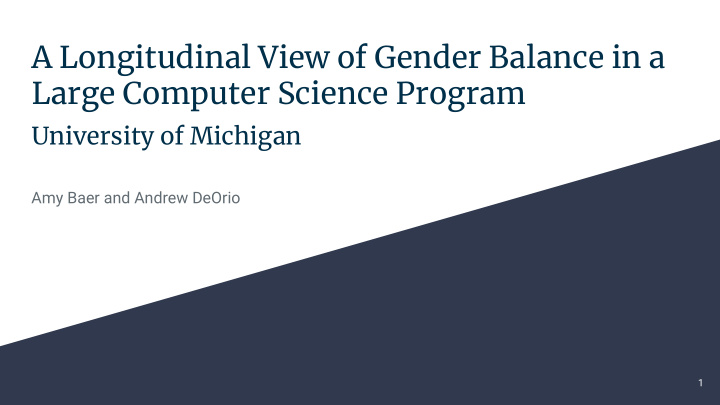



A Longitudinal View of Gender Balance in a Large Computer Science Program University of Michigan Amy Baer and Andrew DeOrio 1
Snapshot of Gender Balance 2 171 Women 617 Men 14 Women 151 Men
Snapshot of Gender Balance 3 50.3% Women 27.5% Women 49.7% Men 72.5% Men
Snapshot of Gender Balance 4 Gender Balance in Courses WN ‘18 Non-Engineering Upper Levels CS1 42% Women 20% Women 57% Men 79% Men
Related Work 5 ● Women are twice as likely to consider leaving a CS major as compared to men [Barker ‘09] Even if they choose to stay, many women do not move to take an industry or academic job in ● the computing field [Beede ‘11, Mavriplis ‘10] Why do women and other minorities leave? ● ○ They feel out of place and as if they do not belong [Sax ‘18] Lack of self confidence [Beyer ‘03] ○ ● Why do women and other minorities stay? Same-gender student interaction, pace and workload of classes, prior experience, and ○ faculty encouragement, etc [Barker ‘09, Cohoon ‘08, Sax ‘18, Miliszewska ‘06]
Research Questions 6 ● Where in the Computer Science curriculum does the gender balance change? ● Do grades play a role in this change?
Curriculum Overview 7 UofM’s Course Sequence
Dataset 8 10 5 years years Fall 2008 - Fall 2013 - Fall 2018 Fall 2018 30,890 21,351 Records Records
Outline 1. Failure rates & Withdrawal rates 2. Attrition rates 3. Effects on Attrition 4. Conclusions 9
Are women failing? 10 Women fail less than men in non-engineering CS1, CS2, and in Upper Levels* ● *statistically significant, p < 0.05
Are women withdrawing? 11 Women withdraw more in non-engineering CS1, CS2, and CS3* ● Difference in means is at most 2.2% ● *statistically significant, p < 0.05
Failure Rate Discussion 12 ● No evidence that women are failing out of the CS sequence ● In CS2 and non-ENGR CS1 , men fail more but women withdraw more Reaction to poor performance may differ depending on their gender ○ ○ Conjecture : Women withdraw when they would have passed while men do not withdraw when they are in danger of failing, resulting in more men failing.
Withdrawal Rate Discussion 13 ● In non-ENGR CS1 , CS2 , and CS3 , women withdraw at a higher rate than men ● Differences in withdrawal rates between men and women could partly explain the lack of women in CS courses ● However , this is likely not a large contributor ○ Magnitude of the difference in withdrawal rates is not great ○ Difference only exists in half of the courses in the sequence Largest difference comes in CS3 with around a 2% ○
Are women passing and choosing not 14 to go on? Women have higher attrition rates than men in both CS1 courses, CS2, and Discrete Math* ● Means differ as much as 14.6% (engineering CS1) ● Attrition decreases as we move through the course sequence ● *statistically significant, p < 0.05
Attrition Rate Discussion 15 ● Women, despite passing, do not move to the next class in the sequence ○ True for Engineering CS1 , Discrete Math , and CS2 but not for CS3 Means differ by 14.6% in ENGR CS1, 9.2% in Discrete Math, and 8.1% in CS2. ○ ● Once students reach CS3, most, regardless of gender, move on to upper level courses ● Why are women choosing not to go on, particularly in courses before CS3?
Are women receiving the same 16 grades as men? Women receive lower grades in engineering CS1, CS2, Discrete Math, and CS3* ● Women have the same or higher cumulative GPAs than men* ● *statistically significant, p < 0.05
Grades Discussion 17 ENGR CS1 , CS2 , Discrete Math , and CS3 : women receive lower grades than men. ● ENGR and non-ENGR women have equally high GPAs as ENGR men and higher GPAs ● than non-ENGR men ○ Women perform just as well if not better in other non-CS, technical courses Why are women receiving lower grades in CS courses but not others? ●
How do grades and gender efgect 18 attrition? Grades are the largest factor in a student’s decision to move on ● Gender, independent of grade, has an effect on a student’s decision to move on* ● *statistically significant, p < 0.05
What causes Attrition Rate 19 discrepancy? ● Gender, independent of any grade received , has an effect on whether or not the student moves on Grades have the largest effect on a student’s decision to move on ● ● What this means: eliminating the grade disparity will improve gender balance but it would not bring the balance to equality
Outline 1. Failure rates & Withdrawal rates 2. Attrition rates 3. Effects on Attrition 4. Conclusions 20
Conclusions & Future Work 21 ● Despite increase in women, there is still a lack of women continuing through the entire program Gender disparity in attrition rates in CS1, CS2, and Discrete Math ● ○ Suggests the problem lies in classes before CS3 ● There are factors other than grades that affect a student’s decision to move on in CS
Future Work 22 ● Why is there a grade imbalance in some classes but not others? How can we rid of the grade imbalance? ● What factors contribute to a student’s decision to move on (other than gender/grades)? ● ● Why is gender a contributing factor to whether a student moves on? ● How can we rid of gender as a factor in a student’s decision to move on? Study replications at other institutions will help solidify this work ●
Recommend
More recommend